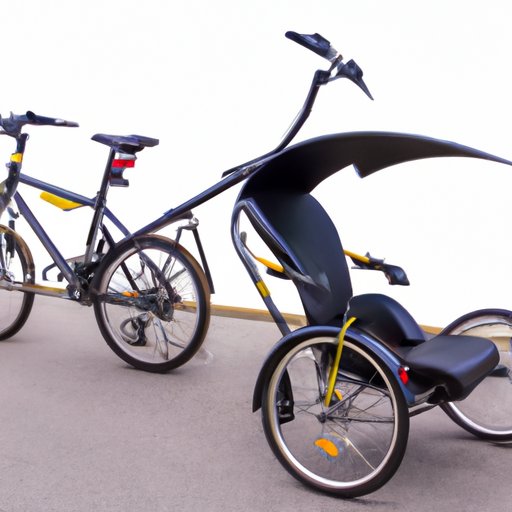Introduction
A recumbent bicycle is a type of bike that has a seat similar to a chair and pedals located in front of the rider. It was designed to provide more comfort than a traditional upright bike and can be used for both recreational and competitive cycling. In this article, we will explore the advantages of riding a recumbent bike, the different varieties available, how to choose the right one, and the health benefits of riding.
Advantages of Riding a Recumbent Bike
Recumbent bikes offer a number of advantages over traditional upright bikes. For starters, they are much more comfortable. The ergonomic seating position reduces pressure on the hands, wrists, neck, and back, making them ideal for riders who suffer from chronic pain or discomfort while riding an upright bike. Furthermore, the improved posture offered by recumbent bikes helps to reduce fatigue, allowing riders to ride for longer periods of time.
In addition to comfort, recumbent bikes also offer improved speed and maneuverability. The aerodynamic design of the bike allows for less air resistance, which translates into faster speeds. The low center of gravity also makes them more stable and easier to control.
Exploring the Different Varieties of Recumbent Bicycles
Recumbent bicycles come in a variety of shapes and sizes, each with its own set of benefits and drawbacks. The most common types are long wheelbase (LWB), short wheelbase (SWB), compact long wheelbase (CLWB), tandem, and folding recumbents.
Long wheelbase recumbents have a longer wheelbase than other types of recumbent bikes. This offers increased stability and improved aerodynamics, making them ideal for touring and racing. However, due to their larger size, they can be difficult to transport and store.
Short wheelbase recumbents have a shorter wheelbase than LWBs, making them more maneuverable and easier to transport. They are also lighter and more affordable than LWBs, making them a great option for commuters and recreational riders. However, their shorter wheelbase can make them less stable at higher speeds.
Compact long wheelbase recumbents are a hybrid between LWBs and SWBs. They offer the stability of an LWB but are more compact and lightweight, making them easier to transport and store. They are also more affordable than LWBs, making them a great option for beginner and intermediate riders.
Tandem recumbents are designed for two riders. They offer improved stability, making them ideal for long-distance rides. However, they are heavier and more expensive than other types of recumbents.
Finally, folding recumbents are designed to be easily folded up for storage and transport. They offer the same benefits as other types of recumbents but are much more portable. However, they are often heavier and more expensive than other types of recumbents.

How to Choose the Right Recumbent Bicycle
When choosing the right recumbent bicycle, there are a few things to consider. First, consider the rider’s size. Recumbent bikes come in a variety of sizes, so it’s important to make sure you choose one that fits the rider properly. Furthermore, consider your budget. Recumbents can range in price from a few hundred dollars to several thousand, so make sure to pick one within your price range.
Next, consider comfort. Make sure the seat is comfortable and supportive, and that the handlebars are easy to reach. Finally, consider the terrain you plan to ride on. Some recumbents are better suited for road riding, while others are designed for off-road trails.

A Guide to Maintaining Your Recumbent Bike
Like any other type of bike, recumbent bicycles require regular maintenance in order to stay in good working condition. This includes cleaning and lubricating the chain, inspecting components, adjusting brakes, and replacing tires when needed. It’s also important to make sure all bolts are tightened, and that the handlebars and seat are adjusted correctly.
Furthermore, it’s important to inspect the frame and wheels for signs of damage or wear. If any parts need to be replaced, take the bike to a qualified mechanic who can help you find the correct parts. Also, make sure to keep track of the maintenance schedule for your bike so that you can keep it in top shape.

The Health Benefits of Riding a Recumbent Bicycle
In addition to being fun and convenient, riding a recumbent bicycle can also be beneficial to your health. Because of the lower impact exercise offered by recumbents, they are ideal for people with joint pain and arthritis. Furthermore, the improved posture provided by the ergonomic seating position can help to improve cardiovascular health and core strength.
Riding a recumbent bike can also help to increase flexibility. The reclined riding position encourages the rider to move through a full range of motion, which can help to stretch and strengthen muscles. Finally, because of the improved aerodynamics offered by recumbents, riders can go farther and faster than they would on an upright bike.
Conclusion
Recumbent bicycles offer a number of advantages over traditional upright bikes, including increased comfort, improved posture, and faster speeds. There are a variety of types of recumbents available, so it is important to choose the right one for your needs. Furthermore, regular maintenance is essential in order to keep your recumbent bike in good working condition. Finally, riding a recumbent bike can offer a number of health benefits, such as low impact exercise, improved cardiovascular health, improved core strength, and increased flexibility.


